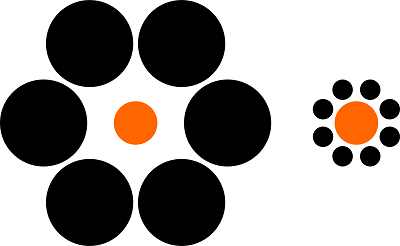
Exploring Relative Size Optical Illusions

Novelist and professor Robertson Davies famously said, “The eye sees only what the mind is prepared to comprehend.” In our day-to-day reality, perception is everything and that’s what makes optical illusions so fascinating. Our eyes relay the truth, but our brain doesn’t always perceive it.
The Ebbinghaus illusion, or Titchener circles, is a famous example of a relative size optical illusion that relies on size and depth perception. As we’ve explained before, the brain has created a few cheats to try and make shortcuts to process all of the information it receives, so it makes assumptions about what it sees.

The trick
If you look at the image above, you probably think the orange circle on the right is larger than the orange circle on the left. When your brain sees the circles, it assumes the smaller circles are further away and the larger circles are closer. Then it automatically believes the center circles are not the same size. The truth is both of the orange circles are the exact same size!
How it works
There’s a theory called the cue theory or cue approach that the brain uses when it sees 2D images. Based on information or cues given in the image, the brain forms an opinion about the actual depth it’s seeing, trying to interpret a 2D image as 3-dimensional.
Seeing 2D vs. 3D
That exercise illustrates the difference between the monocular cues your brain uses when looking at 2D images as opposed to binocular cues it uses for 3D images. Monocular cues only provide relative depth based on other objects in the environment, such as the size of the circles in the image above. The brain fills in ambiguous blanks based on context.
This is how your eyes confuse your brain with relative size optical illusions. Your eyes know your brain will rely on monocular cues!
See for yourself
If you close one eye and look around, you can perceive depth, but size and distance are ambiguous. Now open both eyes. You have absolute information about the objects you’re looking at—you know how close or far away they are from you and their exact size.
The trained brain
Another interesting point about the Ebbinghaus illusion is how much it relies on familiarity with cues in printed images. For example, studies indicate that adults think the two orange circles are different sizes. However, when children look at this illusion, they are often not deceived at all.
Did you know life experiences play a role in how your brain perceives optical illusions? See for yourself in our article about ambiguous images and memory.


